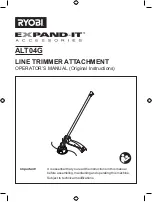
Section 2: Operating Instructions
AP-CC30 Concrete Claw 328-160MK
11/11/19
12
Transport Safety
DANGER
!
To avoid serious injury or death:
•
The operator of this attachment must know how to control
the power machine with attachment and how to stop them
•
Always transport the Concrete Claw low to the ground to
maintain stability and to keep product from falling onto the
operator or a person nearby. Make sure the payload is
carried high enough to keep it from digging into the ground
or from hitting a solid object causing the operator to loose
control of the power machine.
•
Transport slowly with payload in the attachment to allow
time to stop quickly in an emergency.
WARNING
!
To avoid serious injury or death:
•
Follow all safety precautions when transporting a load. Not
using safe transporting methods can damage the equipment
and cause serious injury or death.
•
Only travel on public roadways if the attachment is empty.
Travel in such a way that faster moving vehicles may pass
safely. Use accessory lights, clean reflectors, and a slow
moving vehicle sign that is visible from the back to warn
operators in other vehicles of your presence. Always comply
with all federal, state, and local laws.
•
Keep load centered, even when stopped. This will optimize
load stability and protect against load shifting.
•
Always travel straight up and straight down inclines. Never
•
Always transport over ramps and inclines with the heavy
end of the power machine on the “uphill” side. This may
require one to drive up or back down inclines.
•
Transporting loads across inclines, over ramps, on bumpy,
soft, or slippery surfaces reduces machine stability and lift
capacity. Transporting and lifting loads under these
conditions is extremely dangerous. Follow all transport
instructions in your power machine Operator’s Manual.
Concrete Claw Operation
DANGER
!
To avoid serious injury or death:
The operator of this attachment must know how to control the
power machine with attachment and how to stop them quickly
WARNING
!
To avoid serious injury or death:
•
Read and understand all safety alerts under “Operating
Operating Tips
1. Go slowly when first learning how to operate the
attachment and power machine.
2. Know your surroundings when doing demolition
work. Avoid hitting nearby structures, protrusions,
power lines, underground utilities, etc. Avoid sudden
drop-offs, water edges, inclines, etc. Do not remove a
floor or foundation that is supporting a structure.
3. Keep work area small and travel distance short to
make the job more efficient.
4. When setting up a dump site, choose a site that is
level, clear of low hanging electrical lines, and free of
obstructions such as trees, fences, and buildings.
5. Keep load centered, even when stopped. This will
optimize load stability and protect against load
shifting.
6. Keep attachment low to the ground when
transporting. Always drive up or down slopes with
heavy end of power machine on the uphill side. This
may require the operator to back down or up a slope.
7.
To maintain levelness while raising loader arms or
while traveling up a slope, tilt top of the attachment’s
hitch plate forward as needed.
8. To maintain levelness while lowering loader arms or
traveling down a slope, tilt top of the attachment’s
hitch plate back as needed.
Remove Concrete Slabs
The Concrete Claw is forced under a slab of concrete.
The loader arms may then be raised and top of loader
hitch tilted back or forward to assist breaking the concrete
into slabs. Broken slabs may then be loaded onto the
claw. Larger slabs should be caught in the pin-under top
before transporting.
1. Make sure the load does not exceed rated lift
capacity of the power machine.
2. Position Concrete Claw pointed slightly down in-front
of a section of the concrete to be removed. Do not
ram attachment into the ground. Make a complete
stop and angle the attachment down a few degrees.
3. Drive forward while lowering loader arms to position
the attachment’s teeth at the ground entry point in
front of the slab.













































